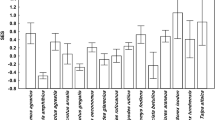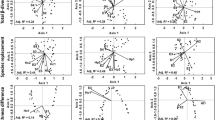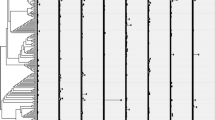Abstract
We studied compositional, phylogenetic, and functional nestedness in the flea assemblages of 14 host species across regions. Our main questions were (a) are a host’s flea assemblages compositionally, phylogenetically, or functionally nested? (b) Do similar processes drive these nestedness facets? (d) Are a host’s biological traits associated with nestedness of its flea assemblages? Rows of host matrices were ordered by decreasing species richness/the sum of the branch lengths of a phylogenetic tree/functional dendrogram or by decreasing region area or by increasing distance from the centre of a host’s geographic range. None of the matrices sorted by species richness/sum of branch lengths were nested from a compositional perspective, but they were significantly nested from phylogenetic and functional perspectives. Compositional, phylogenetic, and functional nestedness of matrices sorted by region area or by distance from the host’s geographic range centre varied between hosts. In some hosts, flea assemblages were nested from all three perspectives independently of how matrix rows were sorted, whereas in other hosts, the occurrence of significant nestedness depended on the order of the matrix rows. The degree of phylogenetic and functional nestedness for matrices sorted by the sum of branch lengths was associated with a host species’ morphoecological traits and the latitude of its geographic range. We conclude that consideration of nestedness based solely on species composition does not allow a comprehensive understanding of the patterns of parasite community structure. Nestedness should also be considered from phylogenetic and functional perspectives.







Similar content being viewed by others
Data availability
The data on fleas and mammals used in the current study can be found in the Dryad Depository (Hadfield et al. 2013; https://doi.org/10.5061/dryad.jf3tj).
References
Almeida-Gomes M, Vieira MV, Rocha CF, Melo AS (2019) Habitat amount drives the functional diversity and nestedness of anuran communities in an Atlantic Forest fragmented landscape. Biotropica 51:874–884. https://doi.org/10.1111/btp.12687
Almeida-Neto M, Guimarães P, Guimarães PR Jr, Loyola RD, Ulrich W (2008) A consistent metric for nestedness analysis in ecological systems: reconciling concept and measurement. Oikos 117:1227–1239. https://doi.org/10.1111/j.0030-1299.2008.16644.x
Atmar W, Patterson BD (1993) The measure of order and disorder in the distribution of species in fragmented habitat. Oecologia 96:373–382. https://doi.org/10.1007/BF00317508
Baber MJ, Fleishman E, Babbitt KJ, Tarr TL (2004) The relationship between wetland hydroperiod and nestedness patterns in assemblages of larval amphibians and predatory macroinvertebrates. Oikos 107:16–27. https://doi.org/10.1111/j.0030-1299.2004.12968.x
Balakrishnan CN, Sorenson MD (2007) Dispersal ecology versus host specialization as determinants of ectoparasite distribution in brood parasitic indigobirds and their estrildid finch hosts. Mol Ecol 16:217–229. https://doi.org/10.1111/j.1365-294X.2006.03142.x
Barton K (2020) MuMIn: multi-model inference. R package version 1.43.17. https://CRAN.R-project.org/package=MuMIn. Accessed Mar 2023
Bellay S, Oda FH, Almeida-Neto M, de Oliveira EF, Takemoto RM, Balbuena JA (2020) Host age predicts parasite occurrence, richness, and nested infracommunities in a pilot whale-helminth network. Parasitol Res 119:2237–2244. https://doi.org/10.1007/s00436-020-06716-1
Brown JH (1984) On the relationship between abundance and distribution of species. Am Nat 124:255–279. https://doi.org/10.1086/284267
Bruun HH, Moen J (2003) Nested communities of alpine plants on isolated mountains: relative importance of colonization and extinction. J Biogeogr 30:297–303. https://doi.org/10.1046/j.1365-2699.2003.00806.x
Calvete C, Blanco-Aguiar J, Virgós E, Cabezas-Díaz S, Villafuerte R (2004) Spatial variation in helminth community structure in the red-legged partridge (Alectoris rufa L.): effects of definitive host density. Parasitology 129:101–113. https://doi.org/10.1017/S0031182004005165
Chen C, Zhan C, Wang Y (2022) Do functional and phylogenetic nestedness follow the same mechanisms as taxonomic nestedness? Evidence from amphibians in the largest archipelago of China. J Anim Ecol 91:2424–2436. https://doi.org/10.1111/1365-2656.13824
Cook RR, Quinn JF (1995) The influence of colonization in nested species subsets. Oecologia 102:413–424. https://doi.org/10.1007/bf00341353
Faith DP (1992) Conservation evaluation and phylogenetic diversity. Biol Conserv 61:1–10. https://doi.org/10.1016/0006-3207(92)91201-3
Fick SE, Hijmans RJ (2017) Worldclim 2: new 1-km spatial resolution climate surfaces for global land areas. Int J Climatol 37:4302–4315. https://doi.org/10.1002/joc.5086
González MT, Poulin R (2005) Nested patterns in parasite component communities of a marine fish along its latitudinal range on the Pacific coast of South America. Parasitology 131:569–577. https://doi.org/10.1017/S0031182005007900
Gotelli NJ (2000) Null model analysis of species co-occurrence patterns. Ecology 81:2606–2621.https://doi.org/10.1890/0012-9658(2000)081[2606:NMAOSC]2.0.CO;2
Goüy de Bellocq J, Morand S, Feliu C (2002) Patterns of parasite species richness of Western Paleartic micro-mammals: island effects. Ecography 25:173–183. https://doi.org/10.1034/j.1600-0587.2002.250205.x
Guégan J-F, Hugueny BA (1994) Nested parasite species subset pattern in tropical fish host as major determinant of parasite infracommunity structure. Oecologia 100:184–189. https://doi.org/10.1007/BF00317145
Hadfield JD, Krasnov BR, Poulin R, Nakagawa S (2013) Data from: a tale of two phylogenies: comparative analyses of ecological interactions. Dryad, Dataset https://doi.org/10.5061/dryad.jf3tj
Hadfield JD, Krasnov BR, Poulin R, Nakagawa S (2014) A tale of two phylogenies: comparative analyses of ecological interactions. Am Nat 183:174–187. https://doi.org/10.1086/674445
Hecnar SJ, M’Closkey RT (1997) Patterns of nestedness and species association in a pond-dwelling amphibian fauna. Oikos 80:371–381. https://doi.org/10.2307/3546605
Heino J, Grönroos M (2017) Exploring species and site contributions to beta diversity in stream insect assemblages. Oecologia 183:151–160. https://doi.org/10.1007/s00442-016-3754-7
Hugueny BA, Guégan J-F (1996) Community nestedness and the proper way to assess statistical significance by Monte-Carlo tests: some comments on Worthen and Rohde’s (1996) paper. Oikos 80:572–574. https://doi.org/10.2307/3546631
Janzen DH (1968) Host plants as islands in evolutionary and contemporary time. Am Nat 102:592–595. https://doi.org/10.1086/282574
Jones KE, Bielby J, Cardillo M, Fritz SA, O'Dell J, Orme CDL, Safi K, Sechrest W, Boakes EH, Carbone C, Connolly C, Cutts MJ, Foster JK, Grenyer R, Habib M, Plaster CA, Price SA, Rigby EA, Rist J et al (2009) PanTHERIA: a species-level database of life history, ecology, and geography of extant and recently extinct mammals. Ecology 90:2648–2648. https://doi.org/10.1890/08-1494.1
Jonsson BG (2001) A null model for randomization tests of nestedness in species assemblages. Oecologia 127:309–313. https://doi.org/10.1007/s004420000601
Junker K, Boomker J, Horak IG, Krasnov BR (2022) Impact of host sex and age on the diversity of endoparasites and structure of individual-based host-parasite networks in nyalas (Tragelaphus angasii Angas) from three game reserves in KwaZulu-Natal province, South Africa. Parasitol Res 121:3249–3267. https://doi.org/10.1007/s00436-022-07653-x
Kelt DA, Rogovin K, Shenbrot G, Brown JH (1999) Patterns in the structure of Asian and North American desert small mammal communities. J Biogeogr 26:825–841. https://doi.org/10.1046/j.1365-2699.1999.00325.x
Krasnov BR (2008) Functional and evolutionary ecology of fleas. Cambridge Univ Press, Cambridge, A model for ecological parasitology
Krasnov BR, Shenbrot GI, Khokhlova IS, Stanko M, Morand S, Mouillot D (2015) Assembly rules of ectoparasite communities across scales: combining patterns of abiotic factors, host composition, geographic space, phylogeny and traits. Ecography 38:184–197. https://doi.org/10.1111/ecog.00915
Krasnov BR, Shenbrot GI, Khokhlova IS (2022) Regional flea and host assemblages form biogeographic, but not ecological, clusters: evidence for a dispersal-based mechanism as a driver of species composition. Parasitology 149:1450–1459. https://doi.org/10.1017/S0031182022000907
Krasnov BR, Shenbrot GI, Khokhlova IS, Degen AA (2004) Flea species richness and parameters of host body, host geography and host ‘milieu’. J Anim Ecol 73:1121–1128. https://doi.org/10.1111/j.0021-8790.2004.00883.x
Krasnov BR, Shenbrot GI, Khokhlova IS, Degen AA (2016) Trait-based and phylogenetic associations between parasites and their hosts: a case study with small mammals and fleas in the Palearctic. Oikos 125:29–38. https://doi.org/10.1111/oik.02178
Krasnov BR, Shenbrot GI, Khokhlova IS, Mouillot D, Poulin R (2008) Latitudinal gradients in niche breadth: empirical evidence from haematophagous ectoparasites. J Biogeogr 35:592–601. https://doi.org/10.1111/j.1365-2699.2007.01800.x
Krasnov BR, Shenbrot GI, Khokhlova IS, Poulin R (2005) Nested pattern in flea assemblages across the host’s geographic range. Ecography 28:475–484. https://doi.org/10.1111/j.0906-7590.2005.04238.x
Kuris AM, Blaustein AR, Alio JJ (1980) Hosts as islands. Am Nat 116:570–586. https://doi.org/10.1086/283647
Laliberté E, Legendre P (2010) A distance-based framework for measuring functional diversity from multiple traits. Ecology 91:299–305. https://doi.org/10.1890/08-2244.1
Laundre JW, Reynolds TD (1993) Effects of soil structure on burrow characteristics of five small mammal species. Great Basin Nat 53:358–366. https://doi.org/10.2307/41712798
Lewontin RC (1974) The genetic basis of evolutionary change. Columbia Univ Press, NY
Lomolino MV (1996) Investigating causality of nestedness of insular communities: selective immigrations or extinctions? J Biogeogr 23:699–703. https://doi.org/10.1111/j.1365-2699.1996.tb00030.x
MacArthur RH, Wilson EO (1967) The theory of island biogeography. Princeton Univ Press, Princeton
Maddison WP, Maddison DR (2021) Mesquite: a modular system for evolutionary analysis. Version 3:70 http://www.mesquiteproject.org. Accessed Mar 2023
Matthews TJ, Cottee-Jones HEW, Whittaker RJ (2015a) Quantifying and interpreting nestedness in habitat islands: a synthetic analysis of multiple datasets. Divers Distrib 21:392–404. https://doi.org/10.1111/ddi.12298
Matthews TJ, Sheard C, Cottee-Jones HEW, Bregman TP, Tobias JA, Whittaker RJ (2015b) Ecological traits reveal functional nestedness of bird communities in habitat islands: a global survey. Oikos 124:817–826. https://doi.org/10.1111/oik.02370
Melo AS, Cianciaruso MV, Almeida-Neto M (2014) tree NODF: Nestedness to phylogenetic, functional and other tree-based diversity metrics. Methods Ecol Evol 5:563–572. https://doi.org/10.1111/2041-210X.12185
Melo AS (2021) CommEcol: community ecology analyses. R package version 1.7.1. https://CRAN.R-project.org/package=CommEcol. Accessed Mar 2023
Morand S, Harvey PH (2000) Mammalian metabolism, longevity and parasite species richness. Proc R Soc Lond B 267:1999–2003. https://doi.org/10.1098/rspb.2000.1241
Moss WE, McDevitt-Galles T, Calhoun DM, Johnson PTJ (2020) Tracking the assembly of nested parasite communities: using β-diversity to understand variation in parasite richness and composition over time and scale. J Anim Ecol 89:1532–1542. https://doi.org/10.1111/1365-2656.13204
Oksanen J, Simpson G, Blanchet F, Kindt R, Legendre P, Minchin P, O'Hara R, Solymos P, Stevens M, Szoecs E, Wagner H, Barbour M, Bedward M, Bolker B, Borcard D, Carvalho G, Chirico M, De Caceres M, Durand S, Evangelista H, FitzJohn R, Friendly M, Furneaux B, Hannigan G, Hill M, Lahti L, McGlinn D, Ouellette M, Ribeiro Cunha E, Smith T, Stier A, Ter Braak C, Weedon J (2022) Vegan: community ecology package. R package version 2.6-4.https://CRAN.R-project.org/package=vegan. Accessed Mar 2023
Patterson BD, Atmar W (1986) Nested subsets and the structure of insular mammalian faunas and archipelagos. Biol J Linn Soc 28:65–82. https://doi.org/10.1111/j.1095-8312.1986.tb01749.x
Patterson BD, Brown JH (1991) Regionally nested patterns of species composition in granivorous rodent assemblages. J Biogeogr 18:395–402. https://doi.org/10.2307/2845481
Poulin R (1996) Richness, nestedness and randomness in parasite infracommunity structure. Oecologia 105:545–551. https://doi.org/10.1007/BF00330018
Poulin R (2007) Evolutionary ecology of parasites, 2nd edn. Princeton Univ Press, Princeton
Poulin R, Guégan J-F (2000) Nestedness, antinestedness, and relationship between prevalence and intensity in ectoparasite assemblages of marine fish: a spatial model of species co-existence. Int J Parasitol 30:1147–1152. https://doi.org/10.1016/s0020-7519(00)00102-8
Poulin R, Valtonen ET (2001) Nested assemblages resulting from host-size variation: the case of endoparasite communities in fish hosts. Int J Parasitol 31:194–1204. https://doi.org/10.1016/s0020-7519(01)00262-4
Poulin R, Valtonen ET (2002) The predictability of helminth community structure in space: a comparison of fish populations from adjacent lakes. Int J Parasitol 30:1235–1243. https://doi.org/10.1016/s0020-7519(02)00109-1
R Core Team (2022) R: a language and environment for statistical computing. R Foundation for Statistical Computing, Vienna https://www.R-project.org
Rohde K, Worthen WB, Heap M, Hugueny B, Guégan J-F (1998) Nestedness in assemblages of metazoan ecto- and endoparasites of marine fish. Int J Parasitol 28:543–549. https://doi.org/10.1016/s0020-7519(98)00013-7
Schliep KP (2011) phangorn: phylogenetic analysis in R. Bioinformatics 27:592–593. https://doi.org/10.1093/bioinformatics/btq706
Seger GDS, Cappelatti L, Gonçalves LO, Becker FG, Melo AS, Duarte LDS (2017) Phylogenetic and functional structure of climbing plant assemblages in woody patches advancing over Campos grassland. J Veg Sci 28:1187–1197. https://doi.org/10.1111/jvs.12568
Shenbrot G, Krasnov B, Khokhlova I, Demidova T, Fielden L (2002) Habitat-dependent differences in architecture and microclimate of the burrows of Sundevall’s jird (Meriones crassus) (Rodentia: Gerbillinae) in the Negev Desert, Israel. J Arid Environ 51:265–279. https://doi.org/10.1006/jare.2001.0945
Spickett A, Junker K, Krasnov BR, Haukisalmi V, Matthee S (2017) Intra- and interspecific similarity in species composition of helminth communities in two closely-related rodents from South Africa. Parasitology 144:1211–1220. https://doi.org/10.1017/S003118201700049X
Surkova EN, Warburton EM, van der Mescht L, Khokhlova IS, Krasnov BR (2018) Body size and ecological traits in fleas parasitic on small mammals in the Palearctic: larger species attain higher abundance. Oecologia 188:559–569. https://doi.org/10.1007/s00442-018-4235-y
Tallamy DW (1983) Equilibrium biogeography and its application to insect host-parasite systems. Am Nat 121:244–254. https://doi.org/10.1086/284054
Timi JT, Poulin R (2003) Parasite community structure within and across host populations of a marine pelagic fish: how repeatable is it? Int J Parasitol 33:1353–1362. https://doi.org/10.1016/s0020-7519(03)00203-0
Ulrich W, Almeida-Neto M, Gotelli NJ (2009) A consumer’s guide to nestedness analysis. Oikos 118:3–17. https://doi.org/10.1111/j.1600-0706.2008.17053.x
Ulrich W, Almeida-Neto M (2012) On the meanings of nestedness: back to the basics. Ecography 35:865–871. https://doi.org/10.1111/j.1600-0587.2012.07671.x
Ulrich W, Kryszewski W, Sewerniak P, Puchałka R, Strona G, Gotelli NJ (2017) A comprehensive framework for the study of species co-occurrences, nestedness and turnover. Oikos 126:1607–1616. https://doi.org/10.1111/oik.04166
Vidal-Martinez VM, Poulin R (2003) Spatial and temporal repeatability in parasite community structure of tropical fish hosts. Parasitology 127:387–398. https://doi.org/10.1017/s0031182003003792
Warburton MV, van der Mescht L, Khokhlova IS, Krasnov BR, Vonhof MJ (2018) Nestedness in assemblages of helminth parasites of bats: a function of geography, environment, or host nestedness? Parasitol Res 117:1621–1630. https://doi.org/10.1007/s00436-018-5844-4
Whitney JE, Gido KB, Martin EC, Hase KJ (2015) The first to arrive and the last to leave: colonisation and extinction dynamics of common and rare fishes in intermittent prairie streams. Freshw Biol 61:1321–1334. https://doi.org/10.1111/fwb.12668
Worthen WB, Rohde K (1996) Nested subsets analyses of colonization-dominated communities: metazoan ectoparasites of marine fishes. Oikos 75:471–478. https://doi.org/10.2307/3545888
Wright DH, Reeves JH (1992) On the meaning and measurement of nestedness of species assemblages. Oecologia 92:416–428. https://doi.org/10.1007/bf00317469
Wright DH, Patterson BD, Mikkelson GM, Cutler A, Atmar W (1997) A comparative analysis of nested subset patterns of species composition. Oecologia 113:1–20. https://doi.org/10.1007/s004420050348
Zelmer DA, Paredes-Calderon L, Leon-Regagnon V, Garcia-Prieto L (2004) Nestedness in colonization-dominated systems: helminth infracommunities of Rana vaillanti brocchi (Anura: Ranidae) in Los Tuxtlas, Veracruz, Mexico. J Parasitol 90:705–710. https://doi.org/10.1645/GE-3316
Zhu Q, Hastriter MW, Whiting MF, Dittmar K (2015) Fleas (Siphonaptera) are Cretaceous, and evolved with Theria. Mol Phylogenet Evol 90:129–139. https://doi.org/10.1016/j.ympev.2015.04.027
Acknowledgements
We thank Samara Bell for helpful comments on the earlier version of the manuscript.
Author information
Authors and Affiliations
Contributions
BRK conceived of the study. BRK, ISK, and GIS collected and analysed the data. BRK drafted the manuscript. All authors finalised the manuscript.
Corresponding author
Ethics declarations
Ethical approval
Not applicable because this study used already published data.
Conflict of interest
BRK is a Subject Editor of Parasitology Research. Other authors declare no competing interests.
Additional information
Handling Editor: Julia Walochnik
Publisher’s Note
Springer Nature remains neutral with regard to jurisdictional claims in published maps and institutional affiliations.
Supplementary information
Rights and permissions
Springer Nature or its licensor (e.g. a society or other partner) holds exclusive rights to this article under a publishing agreement with the author(s) or other rightsholder(s); author self-archiving of the accepted manuscript version of this article is solely governed by the terms of such publishing agreement and applicable law.
About this article
Cite this article
Krasnov, B.R., Shenbrot, G.I. & Khokhlova, I.S. Nestedness of flea assemblages harboured by small mammalian hosts revisited: phylogenetic and functional nestedness do not follow compositional nestedness. Parasitol Res 123, 111 (2024). https://doi.org/10.1007/s00436-024-08132-1
Received:
Accepted:
Published:
DOI: https://doi.org/10.1007/s00436-024-08132-1




